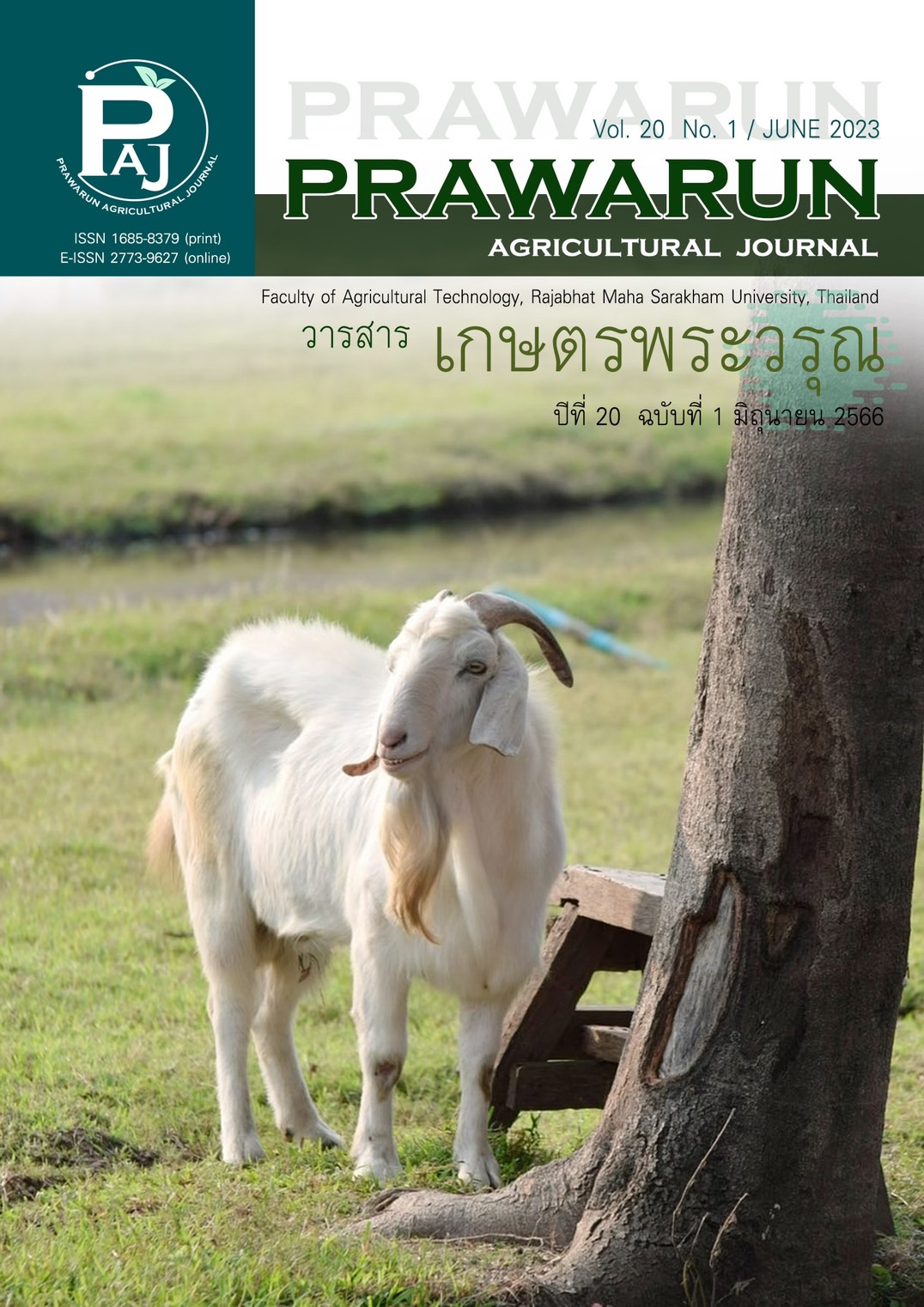ผลของการอบแห้งด้วยลมร้อนต่อสารหอมระเหย สารออกฤทธิ์ทางชีวภาพ และฤทธิ์การต้านอนุมูลอิสระของทุเรียนภูเขาไฟศรีสะเกษ
Main Article Content
บทคัดย่อ
งานวิจัยนี้ได้ศึกษาผลของการอบแห้งด้วยตู้อบลมร้อนแบบถาดของทุเรียนภูเขาไฟศรีสะเกษ เนื้อทุเรียนภูเขาไฟศรีสะเกษที่ระดับการสุกพอดี นำมาอบแห้งด้วยตู้อบลมร้อนแบบถาดที่สภาวะการอบแห้ง 3 ระดับ คือ 50 60 และ 70 องศาเซลเซียส จากนั้นนำตัวอย่างผงมาวิเคราะห์ค่าสี สารประกอบฟีนอลิกและฟลาโวนอยด์ทั้งหมด ฤทธิ์การต้านอนุมูลอิสระ และปริมาณสารหอมระเหย ผลการศึกษาพบว่าการอบแห้งทุเรียนภูเขาไฟที่อบแห้งที่อุณหภูมิ 60 องศาเซลเซียส มีการเปลี่ยนแปลงค่าสี (ΔE) ของทุเรียนภูเขาไฟน้อยที่สุดเมื่อเทียบกับตัวอย่างอบแห้งอื่น ปริมาณสารฟีนอลิกและฟลาโวนอยทั้งหมดลดลงเมื่อเทียบกับตัวอย่างสด ผลการศึกษาฤทธิ์การต้านอนุมูลอิสระด้วยวิธี DPPH และวิธี FRAP ของตัวอย่างทุเรียนอบแห้งมีแนวโน้มไปในทิศทางเดียวกันกับปริมาณสารฟีนอลิกและฟลาโวนอยทั้งหมด โดยตัวอย่างอบแห้งที่ 60 องศาเซลเซียส มีปริมาณสารฟีนอลิกและฟลาโวนอยทั้งหมด ฤทธิ์การต้านอนุมูลอิสระด้วยวิธี DPPH และวิธี FRAP คงอยู่มากที่สุด จากนั้นนำตัวอย่างทุเรียนอบแห้งที่อุณหภูมิ 60 องศาเซลเซียส มาวิเคราะห์ปริมาณสารหอมระเหยโดยวิธี GC-MS โดยพบว่าสาร caryophyllene และ phytol มีปริมาณลดลงหลังจากผ่านการอบแห้ง ในขณะที่สาร bicyclogermacrene มีปริมาณเพิ่มขึ้นหลังผ่านการอบแห้งเมื่อเทียบกับตัวอย่างสด งานวิจัยนี้ชี้ให้เห็นว่าการแปรรูปด้วยตู้อบลมร้อนแบบถาด ส่งผลต่อค่าสี ปริมาณสารออกฤทธิ์ทางชีวภาพและฤทธิ์การต้านอนุมูลอิสระ ปริมาณสารหอมระเหยของทุเรียน ผลการศึกษานี้สามารถนำไปเป็นข้อมูลสำหรับการแปรรูปทุเรียนผงเพื่อนำไปเป็นส่วนผสมในผลิตภัณฑ์อื่น ๆ หรือผลิตภัณฑ์ทุเรียนเพื่อสุขภาพต่อไป
Article Details
เอกสารอ้างอิง
Association of official analytical chemists (AOAC). (1990). Official methods of analysis (15thed.). Washington, D.C.: Association of Official Analytical Chemist.
Arancibia-Avila, P., Toledo, F., Park, Y. S., Jung, S. T., Kang, S. G., Heo, B. G., Lee, S. H., Sajewicz, M., Kowalska, T., & Gorinstein, S. (2008). Antioxidant properties of durian fruit as influenced by ripening. LWT-food Science and Technology, 41(10), 2118-2125. doi :10.1016/j.lwt.2007.12.001
Barbieri, S., Elustondo, M., & Urbicain, M. (2004). Retention of aroma compounds in basil dried with low pressure superheated steam. Journal of Food Engineering, 65(1), 109-115.
Bartley, J. P., & Jacobs, A. L. (2000). Effects of drying on flavour compounds in Australian-grown ginger (Zingiber officinale). Journal of the Science of Food and Agriculture, 80(2), 209-215.doi: 10.1002/(SICI)1097-0010(20000115)80:2<209::AID-JSFA516>3.0.CO;2-8
Díaz-Maroto, M. C., Perez-Coello, M. S., & Cabezudo, M. D. (2002). Effect of drying method on the volatiles in bay leaf (Laurus nobilis L.). Journal of Agricultural and Food Chemistry, 50(16), 4520-4524.
Di Cesare, L. F., Forni, E., Viscardi, D., & Nani, R. C. (2004). Influence of drying techniques on the volatile phenolic compounds, chlorophyll and colour and colour of oregano (Organum vugare L. ssp. prismaticum Gaudin). Italian Journal of Food Science. 16(2), 165-175.
Dinesh Kumar, G., Karthik, M., & Rajakumar, R. (2018). GC-MS analysis of bioactive compounds from ethanolic leaves extract of Eichhornia crassipes (Mart) Solms. and their pharmacological activities. The Pharma Innovation Journal, 7(8), 459-462.
Ketsa, S., & Daengkanit, T. (1998). Physiological changes during postharvest ripening of durian fruit (Durio zibethinus Murray). The Journal of Horticultural Science and Biotechnology, 73(5), 575-577.
Lv, Y., Cai, L., Yang, M., Liu, X., Hui, N., & Li, J. (2017). Purification, characterisation, and thermal denaturation of polyphenoloxidase from prawns (Penaeus vannamei). International Journal of Food Properties, 20(Suppl. 3), S3345–S3359.
Okechukwu, V. U., Eze, S. O., Omokpariola, D. O., & Okereke, J. C. (2021). Evaluation of phytochemical constituents of methanol extract of Moringa oleifera Lam. whole leaf by gas chromatography-mass spectrometry and fourier transform infrared spectroscopy analysis. Natural Sciences, 37, 18-30.
Ouyang, M., Cao, S., Huang, Y., & Wang, Y. (2021). Phenolics and ascorbic acid in pumpkin (Cucurbita maxima) slices: effects of hot air drying and degradation kinetics. Journal of Food Measurement and Characterization, 15(1), 247-255. doi: 10.1007/s11694-020-00618-7
Prasad, K. N., Yang, B., Dong, X., Jiang, G., Zhang, H., Xie, H., & Jiang, Y. (2009). Flavonoid contents and antioxidant activities from Cinnamomum species. Innovative Food Science & Emerging Technologies, 10(4), 627-632. doi: 10.1016/j.ifset.2009.05.009
Raksakantong, P., Siriamornpun, S., Ratseewo, J., & Meeso, N. (2011). Optimized drying of Kaprow leaves for industrial production of holy basil spice powder. Drying Technology, 29(8), 974-983. doi: 10.1080/07373937.2011.558649
Ratseewo, J., Warren, F. J., Meeso, N., & Siriamornpun, S. (2022). Effects of far-infrared radiation drying on starch digestibility and the content of bioactive compounds in differently pigmented rice varieties. Foods, 11(24), 4079. doi: 10.3390/foods11244079
Ratseewo, J., Meeso, N., & Siriamornpun, S. (2020). Changes in amino acids and bioactive compounds of pigmented rice as affected by far-infrared radiation and hot air drying. Food Chemistry, 306, 125644.
Ratseewo, J., Tangkhawanit, E., Meeso, N., Kaewseejan, N., & Siriamornpun, S. (2016). Changes in antioxidant properties and volatile compounds of kaffir lime leaf as affected by cooking processes. International Food Research Journal, 23(1), 188-196.
Siriamornpun, S., Ratseewo, J., Kaewseejan, N., & Meeso, N. (2015). Effect of osmotic treatments and drying methods on bioactive compounds in papaya and tomato. RSC Advances, 5(24), 18579-18587.
Tangkhawanit, E., & Siriamornpun, S. (2021). Bioactive compounds, biological activity, and starch digestibility of dried soy residues from the soybean oil industry and the effects of hot-air drying. Journal of the Science of Food and Agriculture, 102(4), 1719-1728.
Valadez-Carmona, L., Plazola-Jacinto, C. P., Hernandez-Ortega, M., Hernandez-Navarro, M. D., Villarreal, F., Necoechea-Mondragon, H., Ortiz-Moreno, A., & Ceballos-Reyes, G. (2017). Effects of microwaves, hot air and freeze-drying on the phenolic compounds, antioxidant capacity, enzyme activity and microstructure of cacao pod husks (Theobroma cacao L.). Innovative Food Science & Emerging Technologies, 41, 378-386. doi: 10.1016/j.ifset.2017.04.012
Wachtel-Galor, S., Wong, K. W., & Benzie, I. F. F. (2008). The effect of cooking on Brassica vegetables. Food Chemistry, 110(3), 706-710.
Wanyo, P., Meeso, N., & Siriamornpun, S. (2014). Effects of different treatments on the antioxidant properties and phenolic compounds of rice bran and rice husk. Food Chemistry, 157, 457-463. doi: 10.1016/j.foodchem.2014.02.061
Zhang, D., & Hamauzu, Y. (2004). Phenolics, ascorbic acid, carotenoids and antioxidant activity of broccoli and their changes during conventional and microwave cooking. Food Chemistry, 88(4), 503-509.


